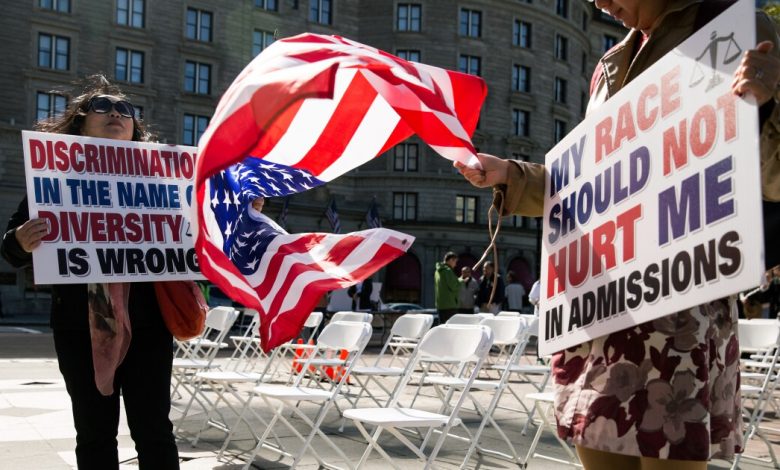The Supreme Court Has Upheld Race-Conscious Admissions Again and Again. Will This Time Be Different?

In the end, Edward J. Blum got what he wanted — another chance to take down race-conscious admissions programs.
On Monday, the Supreme Court agreed to hear two cases brought by Students for Fair Admissions, known as SFFA, against Harvard University and the University of North Carolina at Chapel Hill. Blum, a conservative activist who leads the group, said in a written statement that he hoped the Supreme Court, which has consolidated the two cases, would use them “to begin the restoration of the colorblind legal covenant” by ending the consideration of race in admissions at all public and private colleges in the land.
The end of race-conscious admissions is not a foregone conclusion.
Blum has lost every legal battle in his most recent campaign against race-conscious admissions. But is he poised to win the war?
Yes, a slew of pundits have proclaimed. After all, conservative justices hold a 6-to-3 advantage on the Supreme Court, which, it’s fair to assume, will look skeptically upon even the limited consideration of applicants’ race in admissions.
But the end of race-conscious admissions is not a foregone conclusion, Arthur L. Coleman, co-founder and managing partner at EducationCounsel, told The Chronicle on Monday. “People are once again saying, ‘The sky is falling.’ Stop. We don’t know yet,” he said. “I’m not about to predict with any degree of certainty that this is the death knell for the consideration of race in admissions.”
Many observers were certain that they heard the bells tolling nearly 20 years ago when the Supreme Court heard two legal challenges to race-conscious admissions policies at the University of Michigan at Ann Arbor. But then, in 2003, a 5-to-4 majority upheld the Michigan Law School’s narrowly tailored consideration of race, in Grutter v. Bollinger. The justices ruled that the law school’s individualized review of each applicant — in which race was one of many factors considered — furthered a compelling interest in attaining educational benefits resulting from a diverse student body.
“Despite all the predictions that race-conscious admissions policies were dead, the Supreme Court found a way to thread a needle in 2003,” said Coleman, a former deputy assistant secretary of the U.S. Department of Education’s Office for Civil Rights. “Grutter gave us a very clear road map. Courts have continued to build on that road map, and colleges have relied on that road map. The fact that the Supreme Court has taken the case doesn’t mean it’s poised to wipe out decades of precedent. Facts will matter.”
Handicapping the odds that the Supreme Court will strike down race-conscious admissions programs is tricky. Sure, it’s a fact that Chief Justice John Roberts is no supporter of racial preferences. In a 2006 dissent in a voting- rights case, he wrote: “It is a sordid business, this divvying us up by race.” And in his 2007 majority opinion in a case concerning racial diversity in schools, he wrote: “The way to stop discrimination on the basis of race is to stop discriminating on the basis of race.”
But Roberts may still hesitate before letting the end of an established practice — one that has been reaffirmed over and over again for 40 years — be a part of his legacy. He may worry about how partisan such a decision would appear, legal scholars have said.
In the end, which way Roberts votes might not matter so much. After all, Justices Samuel A. Alito Jr. and Clarence Thomas have previously written critically of race-conscious policies, and the three justices appointed by President Trump — Neil M. Gorsuch, Brett M. Kavanaugh, and Amy Coney Barrett — have tilted the court to the right.
Even if the justices do uphold the precedent, they could impose further restrictions on admissions offices when it comes to considering race, Liliana M. Garces, a legal and education scholar at the University of Texas at Austin, said. They’ve done so before.
In the 1978 decision in Regents of the University of California v. Bakke, for example, Garces noted Justice Lewis F. Powell changed the justification of race-conscious decisions “from this goal of addressing the past discrimination” to a more limited goal of creating “a diverse student body given the educational benefits.”
Already, cases like the ones against Harvard and UNC are having a chilling effect on admissions officials, said OiYan Poon, an associate professor affiliate in the School of Education at Colorado State University. Even though it’s still legal, Poon said, “research has found that there has been a drastic rollback, voluntarily, from considering race in any way, shape, or form.”
If the court were to ban or weaken race-conscious admissions policies outright, “it would really tie the hands of admissions officers and fundamentally shift the college-access agenda,” said Angel B. Pérez, chief executive of the National Association for College Admission Counseling. And the effects, he said, would be felt well beyond admissions offices: “For many students, the first time they encounter people of difference is college. If we made institutions less diverse, we would be hindering that. I worry about what that would mean for the nation.”
As for UNC and Harvard, both said they would continue to defend their admissions practices. Lawrence S. Bacow, Harvard’s president, said in a statement that “the Supreme Court decision to review the unanimous decisions of the lower federal courts puts at risk 40 years of legal precedent granting colleges and universities the freedom and flexibility to create diverse campus communities.” The university does not discriminate, he said.
“The university remains committed to academic excellence, expanded opportunity, and diverse educational experiences,” Bacow said. Beth Keith, the associate vice chancellor for university communications at UNC, said the institution’s admissions process “allows for an evaluation of each student in a deliberate and thoughtful way.”
If the Supreme Court does throw out race-conscious admissions, institutions like Harvard and UNC will be in a difficult position. In an effort to continue to admit diverse classes, legal scholars said they may have to go back to the drawing board and rethink the legal arguments they have used in the more recent admissions cases.
“What does it mean for the Harvards and other influential institutions to push back and say, We’re still going to be considerate about race and what we know it means to consider it and be ready for more legal challenges,” said LaWanda Ward, a legal scholar and assistant professor of education at Pennsylvania State University at University Park. “I think that’s where it goes.”
It wasn’t immediately clear on Monday when the Supreme Court would hear the cases, but legal experts told The Chronicle that they expected it to happen this fall. That would mean a ruling probably wouldn’t come until the summer of 2023.
Many college students took to Twitter on Monday to share their concerns about what the Supreme Court’s ultimate ruling could mean. One of them was Will Walker Jr., a Black graduate student studying higher education and student affairs at the University of Indiana at Bloomington. He told The Chronicle he was frustrated that, in his view, the role that race plays in admissions decisions tends to get much more attention than the role that wealth and privilege play throughout the process: “We’re often not talking about the other forms of preferential treatment in admissions at highly selective institutions where students of color are still largely underrepresented.”
Walker, who graduated from the University of Richmond last year, has considered a career in higher education. But he has worried about a future in which race-conscious admissions programs are extinct. “I have lots of concerns about what the campus environment would become if colleges couldn’t consider race,” he said. “Many of these predominantly white campuses are already very hostile to people of color.”
So on Monday, even as many observers were once again considering the fairness of why some students get in and others don’t, Walker was also thinking about everything that happens after an applicant is accepted. “If we’re focusing on diversity, equity, and inclusion in higher ed, admissions is the starting point, but it can’t be the only point of focus,” he said. “We have to be thinking about how students of color are experiencing the campus environment, and how to support them, whichever way this case turns out.”
The last time the Supreme Court considered a race-conscious admissions case, most experts predicted a slam-dunk win for SFFA’s Blum, who was also the architect of a legal challenge to the University of Texas at Austin’s race-conscious admissions policy. But in 2016, the court ruled 4 to 3, in Fisher v. University of Texas at Austin, that the university’s use of race as a factor in its holistic-process used to fill spots remaining after the state’s Top Ten Percent Plan was narrowly tailored to serve UT’s compelling diversity goals. The surprising ruling was written by Justice Anthony M. Kennedy, a conservative who cast the pivotal vote (and who has since retired from the court).
“That was a case of a justice looking closely at the facts,” said Coleman, with EducationCounsel, “and not being too ideological or categorical.”
And doing the opposite of what most everyone expected.
Source link





